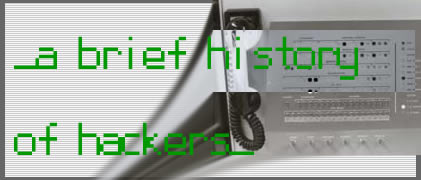

| T.A.Z. Take_Away_Zone #1 |
ART IN THE AGE OF HACKING | at FORUM STADTPARK
- Graz February, 28th - March, 1st 2003 |
|||||||
| T.A.Z. Take_Away_Zone #2 |
|||||||||
| A
[HI]STORY[-TELLING] OF HACKER CULTURES · Year Zero (!) · 1967 PDP-10 - Hacker ethic - ARPAnet · The 1970s Community Memory Group - Felsenstein - Birth of computer underground - Blue Box and Apple · The 1970s The rise of Unix · The 80s Phrack - Free Software Foundation - 2600 · The 90s The "hacker crackdown" and after - The Intel 386 chip - Linux - DeCSS |
 The following notes are a sort of basic "screenplay" for a history of hacking, a 3 decades long thread of facts and trends that drove the very history of computing and its relevance in the social arena. 0: Let's set a year zero. The beginning of it all. Any respectable History has one. Of course we all know that human history began far before this date, but somehow our ancestors felt the need to agree on some date to begin the counting of time. The zero year in the history of hackers is 1961. |
||||||||
1961: The
beginning of the hacker history can be dated to the year MIT
bought the PDP-1, the first microcomputer byDigital Equipment
Corporation's Being the access to the PDP-1 restricted by MIT regulations, and the
eagerness of the TMRC kids to put their hands on the machine almost unbearable,
some ways to gain access to the machine beyond the scheduled times were
to be devised. What might be called the first hack in the entire history was, in fact, the lock-hacking of the TMRC doors. Since the beginning, hacking has been about circumventing limitations that blocked the access to knowledge. |
|||||||||
"S&P people were obsessed with the way The System worked,
its increasing complexities, how any change you
Since the beginning, there was serious respect implied in the use of the word. An hack since the beginning had to be qualify with innovation, style, and technical virtuosity. The most productive people working on Signals and Power called themselves "hackers" with great pride. This is how Peter Samson saw himself and his friends in a poem in the club newsletter: "Switch Thrower for the World,
Dec's Pdp 1 |
|||||||||